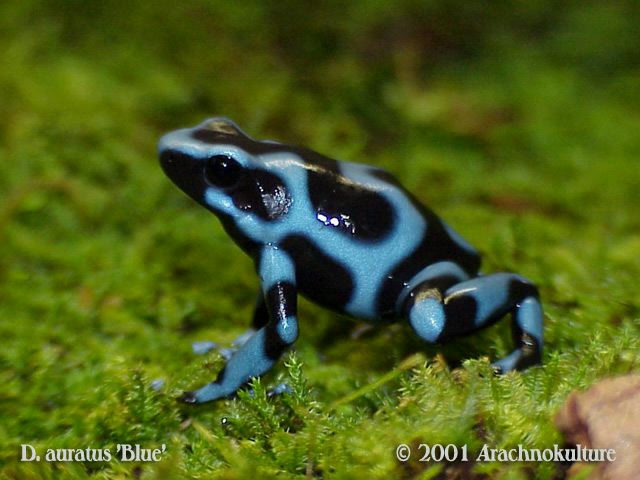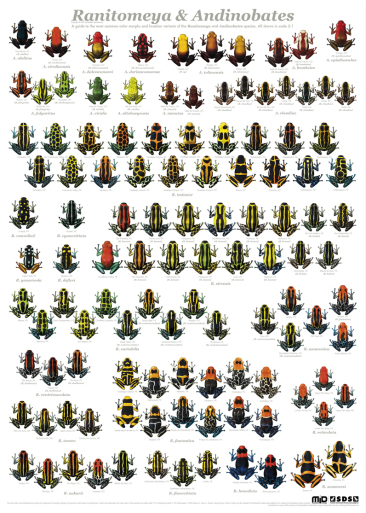When you can look this flamboyant, camouflage is unnecessary.
Charming as their colours are vivid, the poison dart frogs of South America have proved to be some of the most beautiful and iconic symbols of the South American rain forests. These dazzling little amphibians sport such colour as a warning signal to predators. In the wild, bright colour often means "Put me in your mouth and you die". On top of that, they have earned the "dart" part of their name from the way some species have been used by some of the native people. Dipping the head of an arrow into the lifeless body of a frog, and using the toxin for hunting (brutal, I know) was a common practice. But what makes the frogs so unique is their incredible regional diversity. In this post, we'll cover some of the most renown species (and a few of the author's personal favorites, I should mention).
Also, you're reading the first post by one of the new writers named Brenden. If I don't get enough views for this post, Connor and Ray get to take turns beating me with a morning star.
Now, the Azureus have an interesting backstory. Back when they were first discovered in the 1960's, they were classified as their own species. Later, they turned out to be nothing more than a blue morph of the more-common D.tinctorius. They however are exclusive to scattered parts of the Suriname savannas. In recent year's, they have also become some of the staples of the captive frog-keeping community. That neon-blue visage has brought a large number of people into the hobby (fun fact; the author of this post has actually owned a pair of them).
Also, you're reading the first post by one of the new writers named Brenden. If I don't get enough views for this post, Connor and Ray get to take turns beating me with a morning star.
We'll begin with the charismatic Dendrobates tinctorius:
The tinctorius darts, or "tincs" as they've been dubbed in the hobby, are one of the larger species of darts and perhaps the most recognizable. These guys range throughout areas of Guyana, French Guiana, Suriname, and Brazil. They're easily characterized by a generally bulky body, "hunched" back, and large toe pads (primarily on the males). But what makes the tincs really special is how varied they are between location. One of the most notable examples is the formerly-named Dendrobates "azureus".
 |
| The blue ones, yes. |
Moving on, we have the Phyllobates terribilis:
The Phyllobates genus contains some of the largest species of dart frog, the largest being P.terribilis. These hopping vats of toxin hail from the Pacific coast of Columbia. The Terribilis is sometimes called the Golden Dart Frog (not to be confused with the critically-endangered Panamanian Golden Frog), although this species has a few different colour morphs from different localities.
The Mint Green is the most common found in captivity, holding a solid milky-green hue.
The Orange is less common than the Mint, and slightly smaller.
While many members of the Phyllobates genus vary in wild toxicity, P.terribilis has been called the absolute most toxic. A single frog is capable of killing roughly 10 adult men with just one milligram of it's skin toxin. The skin of the frog produces an alkaloid, a fatally-powerful batrachotoxin which shuts down nerves and leaves muscles limp and dead. Because of this less-than-desirable taste, they have very few natural predators. Anything that chows down on this frog is as good as dead (excluding the Liophis epinephelus, which usually only takes on smaller frogs).
Please keep these frogs away from small children that like to stick things in their mouths.
Next in line is the Dendrobates auratus:
D.auratus is a generally Central American species, ranging from Nicaragua and Costa Rica to as far as northern Colombia. However in 1932, the species was introduced in Hawaii. The population ended up gaining their own colour morph, and took fairly well in their island home. Auratus are mostly characterized by having a black or deep bronze tone with asymetrical bright metallic green bands. However this species possesses a great deal of regional diversity in comparison with other dart frogs (if I were to chronicle each different subspecies for each different locality, this post would be very long). Some of the Panamanian species range from vibrant blues to reticulated brown patterns. Auratus are also of the least-concern for protection, being as distributed as they are.
 |
| One of several blue subspecies. |
Now that I've saved the best for last (in the most non-biased way possible), the Ranitomeya:
 |
| Shield your eyes, there's too much pretty-ness. |
The frogs of the Ranitomeya genus are smaller, lighter-built, and hold incredibly high-contrasting colours. Personally, I think they kind of look like paintballs with legs. Or a frog that's been crudely painted by a two-year old. Species of Ranitomeya are greatly distributed around the lowland areas of the Amazon basin, around the northern parts of Peru, and even as far as French Guiana. They're characterized by having a second finger much longer than the first. That and having several different near-metallic colours, many with chain-like patterns across their legs. Ranitomeya darts are often called the "thumbnail" frogs, being that they don't grow to be much larger than half an inch.
Here are a few species that, personally, I think are just downright gorgeous:
Ranitomeya imitator
Imitators have, in the past ten years, become increasingly sought after in the reptile-keeping community. For good reason, too. The frogs have bright, almost electric-looking reticulated patterns across their legs. They've been given the name "imitator" for the fact that they've evolved to mimic other species of thumbnail frogs in appearance (hence the common name, 'the mimic dart frog'). Imitators come in several different patterns from their own localities, most having these reticulated legs patterns. Imitators are found abundantly in northern Peru.
Ranitomeya fantastica


















































